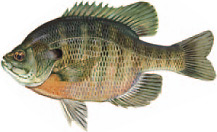 Scientific Name
Scientific Name
Lepomis macrochirus
Other Common Names
Bream, bluegill sunfish, sun perch
Identification
Colors are variable. Dark green, olive-green, olive brown, or bluish-black on its back, fading to yellowish- green or silvery. Normally has five to seven vertical bars extending down on each side. Lower parts of its cheek and gill cover are bluish. Its “throat” is yellow on females to bright orange on the male, brighter during spawning. Has a black, ear-like flap on its opercle (gill cover) and a black blotch at the back base of its spiny dorsal fin. Typically under 1lb. in Virginia.
Best Fishing
Lakes: Western Branch, Prince, Cohoon, Chickahominy, Robertson, Gatewood, Briery Creek, Burke, and many others.
Fishing Techniques
Anumber 8 or 10 hook baited with soft crickets, small nymphs, garden worms, red wigglers, pieces of night crawlers, other grubs and caterpillars on an ultralight spinning or spincasting outfit, fly rod or cane pole provides a lot of fun. Toward evening, in summer, when the shallows cool, bluegills come into shore to feed. When using bait, fish shallow with a small, light bobber in spring, deep near structure in hot summer with no bobber and lightly weighted. Effective artificials include poppers, nymphs, wet and dry flies of many types, rubber spiders, grasshoppers and crickets, and tiny jigs. Flyrodding for bluegills is especially rewarding.
Feeding Habits
Avoracious feeder and usually not too fussy as to what it feeds on. Insects and insect larvae of all kinds, small crustaceans, worms and caterpillars are among its favored foods. Habitat: Quiet streams, ponds, lagoons, and small to medium-sized lakes. Bluegills gather around drop-offs near the edges of weed beds, around sunken islands, off deep points or in creek channels. Look for bluegills in the shade of piers, swimming rafts, tree-shaded shores or points, or under or alongside weed beds, such as lily pads, drop-offs close to shore, downed trees, underwater brush piles or shaded shorelines. Adult fish move to deeper cooler waters during hot weather.
Spawning Habits
Bluegill spawn in late spring and early summer as water temperatures reach 70° to 75°F. Males sweep out dishshaped nests. Males become aggressive in defending the nest and will instinctively strike anything that intrudes upon its nest space to protect rather than out of hunger. After spawning they will remain in the shallow waters for awhile as they roam and feed.


